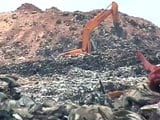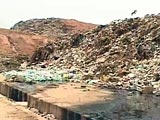This blog can be rightly called 'The Bangalore Garbage Saga'.
The basic strategy is simple and well explained.
 |
| The levels |
While he soldiers on as an Individual, he is also active as a member of the BBMP Expert Committee on Municipal Waste Management...and part of the Solid Waste Management Round Table. And NSR is constantly on the job.
It is his passion to see something is done to clean up this ugly mess. But I find that it is NOT just the garbage that is ugly! While the nexus between contractors, politicians and officials is well known, Ramakanth and many other committed citizens have chosen to work within the system to break the stranglehold the trio have over the management of waste in Bangalore.
And it is not going to be easy as the system of exploitation is well entrenched and why would anyone give up the easy pickings? Only a smart and a responsible government that can find a way out of this, by creating alternatives for those affected. You just cannot wish them away. Look at the way this group of people have been dumping garbage near villages for the last ten years. Obviously their conscience, if they have any, has not been pricked. I am not sure whether they are even god-fearing! I would have nightmares if I knew I was directly responsible for the sickness in these villages.
In fact, we the city-dwellers are also responsible. We all share the blame in one way or the other. It is probably this guilt, apart from the stench that has made many citizens act. I spoke to Dr. Meenakshee Bharat, an activist involved deeply in this war on garbage, and she said that apart from the ugliness she was deeply worried about the health hazards created by the garbage strewn around the city.
The latest is the involvement of the High-court because of an PIL and its weekly follow up on the progress on its directives. The group of people involved with PIL are patient, unafraid and not one to give up. There is hope something good will come out of their efforts.
If you wonder why is the high court involved in all this, it proves you have been away and have not kept track. Often times it appears that the executive wing, namely politicians and bureaucrats who should implement; appear lethargic, uncaring or just unpredictable. A friend who knows better said that a politician having made so many promises to so many diverse groups of people that he takes shelter in a court order to explain if he has to renege on his promise. And it is the bureaucrat who takes the heat from the judiciary. Very complex.
But it is clear that without a PIL and the judiciary taking it seriously, the garbage crisis would have gone on forever. And I guess there are attempts to scuttle the court directives through various means!
Since his involvement began in SWM, he is busy giving workshops to individuals and various organisations. A grass roots approach. He talks to the lower officials in BBMP and others and coaxes them to act. He goes to schools and enthuses children to get involved.
He is pleased to say that 100 apartment buildings consisting of 25,000 flats have adapted the system and 12 hotels invited him to give workshops and 7 of them have implemented. Hospitals generally have a garbage handling system of their own and few have adapted the more broader methods of handling garbage. Among public limited companies HAL and BEL have adopted, BHEL is in process.
He is pleased to say that 100 apartment buildings consisting of 25,000 flats have adapted the system and 12 hotels invited him to give workshops and 7 of them have implemented. Hospitals generally have a garbage handling system of their own and few have adapted the more broader methods of handling garbage. Among public limited companies HAL and BEL have adopted, BHEL is in process.
He is disappointed that while the strategy is to REDUCE, in reality the opposite is happening. For instance in a traditional South Indian wedding lunch which is served many innovations have been added. The grand way a roll of paper is unfurled over the table is impressive. And the table is cleared in a jiffy as the paper is just folded along with the banana leaf. Then there is the plastic bottle of water, a safe bet after our tap water became unsafe and the tissues at the wash basin to dry your palm .
And now the ultimate, a small pellet transforms itself into a wet tissue when you pour water on it.
This tendency of using tissue paper, bottled water and paper cups is not easy to change.
 |
| A small pellet expands vertically as water is poured on it. |
And now the ultimate, a small pellet transforms itself into a wet tissue when you pour water on it.
This tendency of using tissue paper, bottled water and paper cups is not easy to change.
He says a few have adapted, using plastic cups instead of paper cups. Thick plastic glasses which can be recycled could also be used. Plastic cups can be recycled, if segregated and kept clean .
This is just one example and there are many! Organisers of conferences, events, weddings and other functions all have the 'Use and throw' mind set.. They and the caterers are not easy to convince. But excuses are plenty, cleaning is not up-to the standard, labor is not available and also water is scarce. All justifiable. So it is easier to ignore the advises given. Convincing takes a lot of effort and NRI ‘s are more difficult to convince!
He has many suggestions to offer: Leftover food to be preserved separately which can be used to produce bio-gas or food for piggeries. Regards plantain leaves rolled along with paper, 90 % can be recycled if segregated ..
This is just one example and there are many! Organisers of conferences, events, weddings and other functions all have the 'Use and throw' mind set.. They and the caterers are not easy to convince. But excuses are plenty, cleaning is not up-to the standard, labor is not available and also water is scarce. All justifiable. So it is easier to ignore the advises given. Convincing takes a lot of effort and NRI ‘s are more difficult to convince!
He has many suggestions to offer: Leftover food to be preserved separately which can be used to produce bio-gas or food for piggeries. Regards plantain leaves rolled along with paper, 90 % can be recycled if segregated ..
In his experience in any apartment complex say out of 600 flats 10% do not segregate.. so local volunteers are needed to monitor… 90% are ladies and they are good.. working ladies devote week ends…
Hopes that BBMP will get stricter in enforcing segregation. He feels real commitments are needed. And there is a need for follow up and even punish those who do not segregate. Inspectors should make surprise inspections..on individual houses as well…to fine (Rs.100) if they do not segregate.
I also asked NSR about the concrete dust bins which was a common sight in my younger days! And about the small trolleys pushed by women I see in Kumara Park. He said that around the year 2000 dustbins were removed and a new system was intoduced in Bangalore. He said the idea was inspired by the Singapore model. It was a brilliant idea but it seems it has gone the way of all good intentions in our city.
The idea of pourakarmikas while it appeals, it is almost Gandhian, the system is flawed. It is nice to imagine a dedicated person moving around the community collecting garbage, segregating and delivering to the collecting point and so on. But employing these small time contractors is not efficient. There is no supervision of their work and obviously no commitment. NSR also noted that the trolleys are not maintained well and once the bearings go, it is hard for the women to pull them with a load.
I have seen a trolley with just a broom and a couple of plastic bags hanging on them. And I have seen trolleys full of garbage parked next to a garbage dump on the road. There is also the usual complaint about contractor not paying their workers.
Around 50 workers participated in the protest and demanded that the system of paying wages through contractors should be done away with and instead the money reach them directly from BBMP. ...
It is not just the BBMP or the contractors, it is also us.. I quote:
Though the bins were removed .., people still think of the area as a place to dump garbage. The look and feel of the area just adds to this assumption.
...... SM Krishna became Chief Minister, and declared that Bangalore will be like Singapore, and set up a new garbage collection system. He banned the street dustbin, and set up a door-to-door garbage collection system – using pushcarts and small three-wheeler autos. It was made illegal to dump garbage on street corners, people had to retain their daily garbage at home till the pickup person came to their home to collect. It was a total change in approach – a radical change of the way things had been for decades. It’s a good system, an ambitious system, but people are bad.”
.....Old habits die hard. Rather than wait for collection, people come here and dump like they always used to – as this ‘point’ was the location of the old community dustbin. . – the fact that the physical bin is gone means nothing. People are used to walking around the corner and dumping at their convenience – they can’t be bothered waiting for the pickup person”. The Ugly Indian
Hopes that BBMP will get stricter in enforcing segregation. He feels real commitments are needed. And there is a need for follow up and even punish those who do not segregate. Inspectors should make surprise inspections..on individual houses as well…to fine (Rs.100) if they do not segregate.
I also asked NSR about the concrete dust bins which was a common sight in my younger days! And about the small trolleys pushed by women I see in Kumara Park. He said that around the year 2000 dustbins were removed and a new system was intoduced in Bangalore. He said the idea was inspired by the Singapore model. It was a brilliant idea but it seems it has gone the way of all good intentions in our city.
The idea of pourakarmikas while it appeals, it is almost Gandhian, the system is flawed. It is nice to imagine a dedicated person moving around the community collecting garbage, segregating and delivering to the collecting point and so on. But employing these small time contractors is not efficient. There is no supervision of their work and obviously no commitment. NSR also noted that the trolleys are not maintained well and once the bearings go, it is hard for the women to pull them with a load.
I have seen a trolley with just a broom and a couple of plastic bags hanging on them. And I have seen trolleys full of garbage parked next to a garbage dump on the road. There is also the usual complaint about contractor not paying their workers.
 |
| Mid day and his trolley is empty! |
Around 50 workers participated in the protest and demanded that the system of paying wages through contractors should be done away with and instead the money reach them directly from BBMP. ...
It is not just the BBMP or the contractors, it is also us.. I quote:
Though the bins were removed .., people still think of the area as a place to dump garbage. The look and feel of the area just adds to this assumption.
...... SM Krishna became Chief Minister, and declared that Bangalore will be like Singapore, and set up a new garbage collection system. He banned the street dustbin, and set up a door-to-door garbage collection system – using pushcarts and small three-wheeler autos. It was made illegal to dump garbage on street corners, people had to retain their daily garbage at home till the pickup person came to their home to collect. It was a total change in approach – a radical change of the way things had been for decades. It’s a good system, an ambitious system, but people are bad.”
.....Old habits die hard. Rather than wait for collection, people come here and dump like they always used to – as this ‘point’ was the location of the old community dustbin. . – the fact that the physical bin is gone means nothing. People are used to walking around the corner and dumping at their convenience – they can’t be bothered waiting for the pickup person”. The Ugly Indian



















I am intrigued bythe quote from Mr Lakshminarayana, BBMP Chairman stating that garbage is a problem. It is the normal result of human living and has to be addressed and not warded off as a problem to be circumvented. That attitude as well as the fiscal output from trash that is the crux of the matter. Surat got cleaned after the plague outbreak, should we await such an eventuality? It is sobering to remember that this part of Karnataka is the only living endemic area for plague.
That was indeed a very good blog - informative and thought provoking.
As you say, there has been more verbiage on this issue !
Anyway, let's hope your wish for a clean 2015 Bengaluru comes true.
If not anything, even a good start to achieve that in future will be a big leap forward.
HAPPY NEW YEAR.
Prasan.
Saw this article in today's paper, an interesting read, especially the comparison with China where the author is based.
"Challenging the humiliating, unhygienic practices of public defecation (as well as betel juice spitting and general garbage-dropping), is long-overdue in rural and urban India. One of the biggest killers in India in the world is not Ebola, Aids, or cancer: it’s diarrhoea linked to unclean practices. The medical journal, The Lancet, has revealed that every year, over one lakh children below the age of 11 months die of diarrhoea in India. Unlike the high profile diseases de nos jours, diarrhoea is not a subject that sits well at dinner parties."
Wishing you and Tara a cleaner Bangalore and a healthy and happy New Year !
Lalitha Srinivasan
check GarbageDisposerReviews.com for all your garbage disposal related stuffs.
Thanks